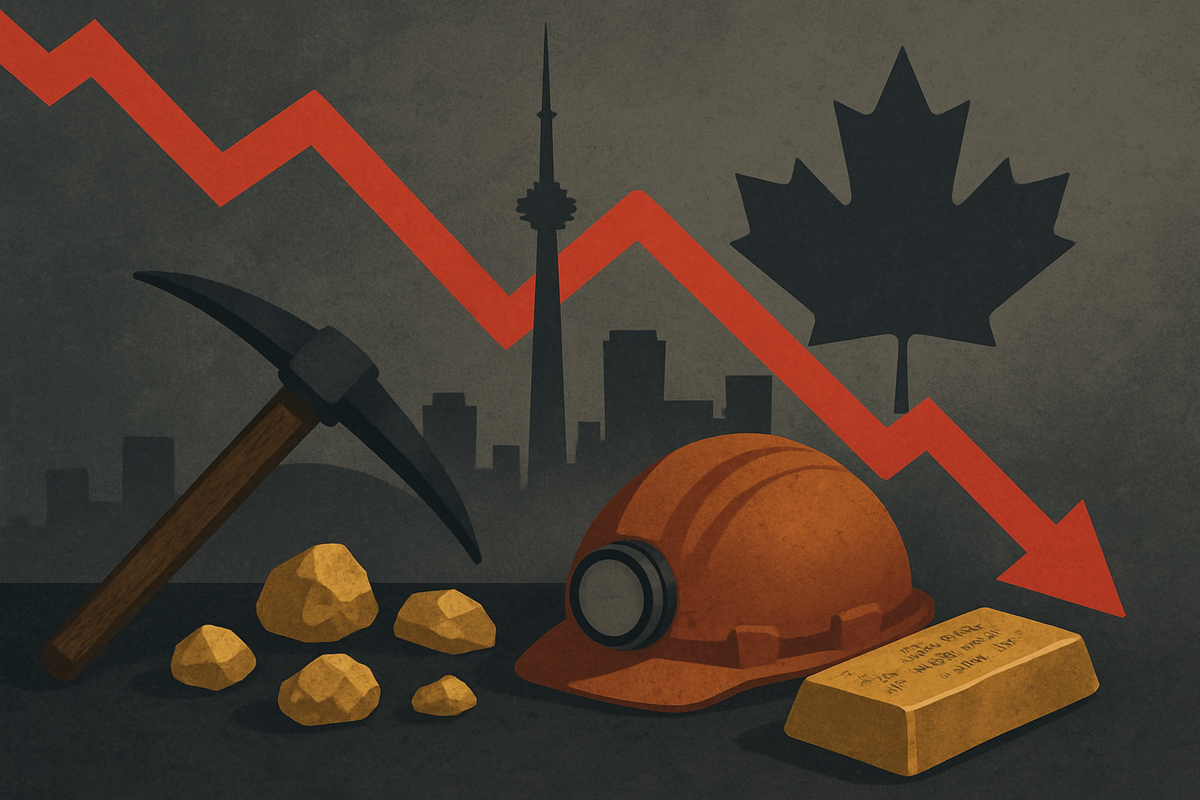
The Toronto Stock Exchange (TSX) recently experienced a significant downturn, primarily driven by a sharp decline in the gold mining sector. This event, unfolding across October 21st and 22nd, 2025, saw Canada's main stock index underperform its U.S. counterparts, revealing immediate implications for the broader market and highlighting the TSX's inherent sensitivity to commodity price fluctuations. The underperformance of these resource-heavy sectors is often interpreted as an early signal of investor caution, prompting a potential shift in market sentiment.
This market correction underscores the precarious balance between gold's role as a safe-haven asset and its susceptibility to profit-taking after extended rallies. The immediate aftermath saw investors pivoting towards more defensive sectors, indicating a search for stability amidst the volatility that gripped commodity-linked stocks. This dynamic not only impacts the valuations of specific mining companies but also casts a shadow on the Canadian dollar and influences expectations for future monetary policy from the Bank of Canada.
Gold's Glitter Fades: A Deep Dive into the Market Correction
The catalyst for the TSX's recent slide was a notable pullback in gold prices, which had enjoyed an extraordinary rally throughout 2025, reaching unprecedented highs. On October 21st, gold spot prices reportedly fell by over 3.5% from their recent peak, while the following day, bullion plunged by more than 6%, marking its largest single-day drop in over 12 years. This swift decline triggered an immediate and substantial impact on public gold mining companies listed on the TSX.
The S&P/TSX Composite Index, with its substantial weighting in mining and materials, dropped sharply by approximately 1.6% on October 21st, with the Materials Capped Index suffering an even steeper decline of as much as 7.7%. The downturn continued into October 22nd, with the TSX Composite Index falling by nearly two percent, its steepest single-day decline in over six months. Major gold producers like Kinross Gold Corporation (TSX: K), Alamos Gold Inc. (TSX: AGI), Agnico Eagle Mines Limited (TSX: AEM), Barrick Gold Corporation (TSX: ABX), and Newmont Corporation (TSX: NGT) saw their share prices plummet by 8% to over 11%.
This correction in gold prices was attributed to a confluence of factors: widespread profit-taking after gold's sustained ascent, a strengthening U.S. dollar, and signs of easing U.S.-China trade tensions, which collectively diminished gold's appeal as a safe-haven asset. Leading up to this, gold had surged past $4,000 per ounce for the first time in October 2025, reaching a record high of US$4379.13 on October 17th, fueled by global economic uncertainty and expectations of further interest rate cuts by the U.S. Federal Reserve. However, higher-than-expected Canadian inflation data (2.4% in September) tempered some expectations for an imminent Bank of Canada rate cut, further contributing to the market's choppiness.
Shifting Fortunes: Winners and Losers in the Gold Market's Wake
The recent downturn in gold prices has had a profound and immediate impact on gold mining companies, while also highlighting the resilience of other market segments. Gold miners are acutely sensitive to price fluctuations, as their revenues are directly tied to the market value of the precious metal. A decline in gold prices directly compresses their profit margins, often leading to amplified drops in their stock values—a 10% fall in gold can translate to a 15-20% decline in mining stock values. Companies with higher All-in Sustaining Costs (AISC) are particularly vulnerable, facing rapid margin erosion and potential operational reviews.
Among the prominent losers were major Canadian gold producers. Kinross Gold Corporation (TSX: K) saw its shares slide significantly, while Alamos Gold Inc. (TSX: AGI) retreated, and Agnico Eagle Mines Limited (TSX: AEM) was off considerably. Barrick Gold Corporation (TSX: ABX) and Newmont Corporation (TSX: NGT), two of the largest global gold miners, also experienced substantial declines. Other notable laggards included Lundin Gold (TSX: LUG), Aya Gold & Silver (TSX: AYA), Seabridge Gold (TSX: SEA), Orla Mining (TSX: OLA), and Discovery Silver (TSX: DSV), all of whom faced sharp declines in their stock values. These companies now face pressures to implement cost-cutting measures, defer capital expenditures, and potentially reduce exploration budgets to maintain profitability in a lower-price environment.
Conversely, certain entities and sectors demonstrated greater resilience or even benefited from the market shift. Gold streaming and royalty companies, such as Franco-Nevada Corporation (TSX: FNV) and Wheaton Precious Metals Corp. (TSX: WPM), typically exhibit lower volatility. Their business model, which involves providing upfront financing to miners in exchange for future production at a fixed discount, insulates them from direct mining costs and operational risks. While not entirely immune to market sentiment, their structural advantages offer a degree of protection. Furthermore, in a broader market rotation, defensive sectors like telecom and industrials experienced gains, suggesting investors were seeking stability. Short sellers betting against gold or gold mining stocks also realized significant profits, while long-term institutional investors may view this period as a strategic buying opportunity to acquire assets at a discount, anticipating a future recovery in gold prices.
Beyond the Miners: Wider Implications for Canada's Economy
The recent drag from gold miners on Toronto stocks is more than just a sector-specific event; it carries wider significance for Canada's resource-heavy economy and its financial markets. As the world's fourth-largest gold producer, Canada's economic health is intrinsically linked to the performance of its mining sector, which contributed an estimated $117 billion to the nation's GDP in 2023. This event underscores the inherent volatility of commodity markets and the amplified sensitivity of the S&P/TSX Composite Index to global commodity price swings.
This market correction fits into a broader trend of gold transitioning between its roles as a safe-haven and a speculative asset. The recent pullback, driven by profit-taking and diminishing safe-haven demand due to easing geopolitical tensions, contrasts with gold's earlier rally in 2025, which was fueled by global uncertainty and central bank purchases. This highlights the complex interplay of factors influencing gold prices. For the industry, sustained lower gold prices could lead to operational reviews, aggressive cost-cutting, and reduced investment in exploration and development, potentially impacting job growth in mining-dependent communities and related industries.
The ripple effects extend to various stakeholders. Suppliers of mining equipment and services would likely see reduced demand, while financial institutions with exposure to the mining sector could face increased risk. The Canadian dollar (CAD) could also face downward pressure, as gold is typically priced in USD, making it less valuable in foreign currency terms. Government revenues from corporate taxes on mining companies would also decrease, potentially impacting public spending. On the policy front, this event might prompt regulatory bodies to consider monetary and fiscal responses, potentially including targeted support for the mining sector or initiatives to further economic diversification. Canada's Critical Minerals Strategy, aimed at streamlining regulatory processes and fostering sustainable practices, could gain renewed emphasis as the government seeks to bolster the resilience of its resource sector.
Historically, the TSX's reliance on commodity prices has been a recurring theme. Comparisons can be drawn to past periods of commodity price volatility, such as the 1970s stagflation era or the recovery after the 2008 financial crisis, where commodity price surges aided the TSX's rebound. Even the Great Depression, which saw the Toronto Stock Exchange crash in 1929, was partly triggered by widespread drops in world commodity prices. These historical precedents demonstrate that while commodity downturns can significantly impact the TSX, the Canadian market has often shown resilience, sometimes aided by government intervention or subsequent recoveries in commodity prices, underscore the importance of diversified portfolios and a long-term investment perspective.
The Road Ahead: Navigating Volatility and Opportunities
The recent slip in Toronto stocks due to gold miners dragging sets the stage for a dynamic period ahead, characterized by both challenges and opportunities for the Canadian market and the gold sector. In the short term (next 12-18 months), the TSX is expected to continue its growth trajectory from 2024, albeit with increased volatility and a potentially slower pace of gains. Earnings growth is anticipated to accelerate, supported by a resilient consumer and gradually falling interest rates. However, the TSX will remain highly sensitive to gold price fluctuations, and external risks such as potential U.S. tariffs could temper overall market performance. For gold miners, continued volatility is likely as gold prices seek new support levels after their recent pullback. Despite these short-term corrections, the overall long-term outlook for gold remains predominantly bullish, with forecasts for 2025 gold prices generally sitting between $2,000 and $3,000 per ounce, and some even predicting $4,200-$4,400 by year-end.
Looking further out (3-5+ years), the long-term possibilities for both Toronto stocks and gold miners are generally positive. The TSX is projected to reach 30,000+ by 2028-2030, driven by sustained economic expansion and robust corporate earnings. For gold, the long-term outlook is even more bullish, with many analysts projecting prices to reach $5,000 per ounce by 2026 and potentially higher by 2030, fueled by factors like de-dollarization trends, persistent central bank purchases, and ongoing geopolitical risks. The global gold mining market is also projected to grow at a CAGR of 3.5% from 2025 to 2035, reaching a market value of $314.7 billion.
To navigate this evolving landscape, strategic pivots and adaptations will be crucial. For gold miners, this means a greater emphasis on technological advancement, including automation, AI, and advanced exploration techniques, to enhance efficiency, safety, and environmental sustainability. Sustainable practices, addressing climate change risks, and robust cost management will also be paramount. The industry may also see increased mergers and acquisitions (M&A) as companies streamline operations and make strategic acquisitions. For the broader TSX, investors should prioritize portfolio diversification, focus on corporate earnings growth, and explore opportunities in sectors beyond traditional resources, such as technology and infrastructure.
Market opportunities will emerge from the expected continued bull market for both Canadian equities and gold, coupled with anticipated interest rate cuts. Strong gold demand from central banks and safe-haven buying amidst geopolitical risks will continue to support prices. Challenges will include increased market volatility, geopolitical uncertainties, lingering inflation concerns, and a potentially strengthening U.S. dollar, which can weigh on gold prices. Overall, while short-term corrections are expected, the long-term trajectory for both Toronto stocks and gold miners appears positive, albeit requiring strategic adaptation and careful risk management.
A Golden Reset: Assessing the Market's New Equilibrium
The recent turbulence on the Toronto Stock Exchange, triggered by a significant drag from gold miners, serves as a crucial reminder of the Canadian market's deep ties to commodity prices and the inherent volatility within the gold sector. The sharp decline in gold prices, driven by profit-taking and shifting market dynamics, has forced a re-evaluation of investor sentiment and strategic positioning. This event highlights that even after an extraordinary rally, gold remains susceptible to corrections, which are amplified in the equity valuations of mining companies.
Moving forward, the market is likely to operate within a new equilibrium, characterized by increased scrutiny on gold miners' operational efficiencies and cost structures. Companies with lower All-in Sustaining Costs (AISC) and robust balance sheets will be better positioned to weather price fluctuations, while others may face significant pressure to adapt. The shift in investor capital towards more defensive sectors indicates a cautious outlook, but also points to potential opportunities in areas less exposed to commodity price swings.
Investors should watch for several key indicators in the coming months: the trajectory of gold prices, which will be influenced by central bank policies, inflation data, and geopolitical developments; the Canadian dollar's performance; and the Bank of Canada's stance on interest rates. Furthermore, the strategic responses of major gold mining companies—whether through aggressive cost-cutting, technological adoption, or M&A activity—will be critical in shaping their individual and collective performance. While the short-term outlook suggests continued volatility, the long-term fundamentals for gold, supported by structural demand and ongoing global uncertainties, remain largely positive. This period of adjustment, therefore, presents both challenges for vulnerable entities and strategic opportunities for resilient companies and discerning investors.
This content is intended for informational purposes only and is not financial advice





